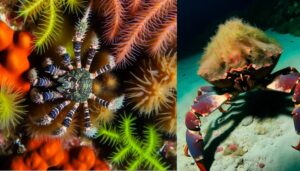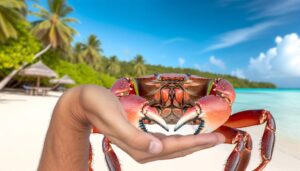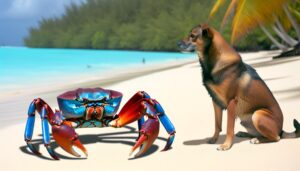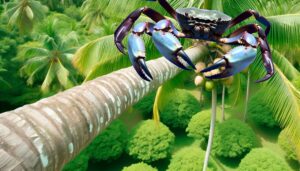Do Crabs Eat Ghost Shrimp in Your Aquarium?
Coconut crabs don't taste like coconut despite their name and diet. Their flavor profile is complex, featuring sweet, nutty, and savory notes, influenced by their consumption of fruits, nuts, seeds, and carrion.
Scientific studies have not conclusively linked their diet to a distinct coconut flavor. Various factors, including habitat, preparation methods, and individual palates, contribute to this unique taste experience.
While traditional Pacific Islander recipes highlight their culinary potential, the intricate flavor results from dietary habits and metabolic processes. For a deeper understanding of these fascinating crustaceans, further analysis of their diet and environment reveals much more.
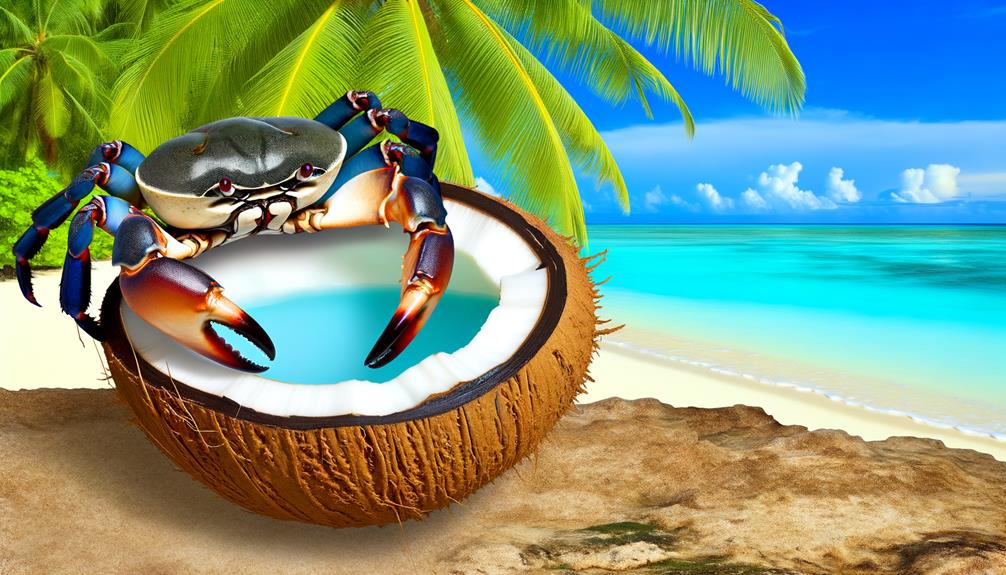
Key Takeaways
- The flavor of coconut crabs is complex, with sweet, nutty, and savory notes.
- The crabs' diet of coconuts, fruits, and marine organisms contributes to their taste.
- Studies have not conclusively linked their diet to a definitive coconut flavor.
- Factors like habitat, diet composition, and preparation methods influence their flavor.
- Individual palates and culinary techniques lead to varying taste experiences.
Habitat and Characteristics
Coconut crabs, Birgus latro, inhabit coastal regions and islands across the Indo-Pacific, thriving in environments rich in dense vegetation and rocky crevices. These terrestrial crustaceans exhibit remarkable adaptations, including powerful pincers capable of exerting immense force, used for climbing trees and cracking open coconuts.
They possess a tough exoskeleton that provides protection, while their large size, reaching up to 4 kilograms, distinguishes them from other crab species. Nocturnal by nature, they seek shelter during the day in burrows, which they line with coconut fibers to maintain humidity.
Birgus latro demonstrates specialized respiratory adaptations, utilizing branchiostegal lungs that allow them to breathe air, an essential trait for their terrestrial existence. Their habitat preference underscores their need for both terrestrial and coastal features.
Diet of Coconut Crabs
Thriving on a diverse diet, coconut crabs primarily consume fruits, nuts, seeds, and the flesh of dead animals, showcasing their opportunistic feeding behavior. Research indicates they frequently crack open coconuts with their powerful claws to access the nutritious meat inside. This species also scavenges for carrion, which supplements their diet with essential proteins.
Observations reveal that coconut crabs exhibit foraging behaviors during nighttime, reducing predation risks. They're known to climb trees to reach food, demonstrating remarkable adaptability. Studies show their diet significantly influences their growth and reproductive success.
Culinary Uses
Given their diverse diet and adaptability, coconut crabs have become a subject of interest in culinary circles, where their unique flavor profile is explored and appreciated. Researchers have identified several methods of preparation that highlight the crab's distinct characteristics:
- Grilling: Heat application caramelizes the natural sugars, enhancing sweetness.
- Steaming: Retains moisture and preserves the crab's delicate texture.
- Baking: Allows for the infusion of herbs and spices, creating a nuanced taste.
- Sautéing: Quick cooking in oil accentuates the crab's savory elements.
Scientists note that traditional Pacific Islander recipes often incorporate coconut crabs, emphasizing their nutritional value. Observations demonstrate that the cooking method significantly impacts the overall sensory experience, encouraging further culinary experimentation and refinement.
Flavor Profile
The flavor profile of coconut crabs is a subject of scientific scrutiny, revealing a complex interplay of sweet, nutty, and savory notes that reflect their diverse diet and unique physiology.
Researchers have noted that the crabs' consumption of coconuts, fruits, and smaller animals imparts a nuanced taste. The sweet undertones are attributed to their fruit intake, while nutty flavors likely arise from their coconut consumption. Savory elements, on the other hand, are linked to their protein-rich diet of smaller marine organisms.
The crabs' unique physiology, including their ability to metabolize different food sources efficiently, enhances this intricate flavor profile. The resulting taste experience is hence a composite of their dietary habits and metabolic processes, offering a multifaceted culinary experience.
Myth or Reality?
Despite the intricate flavor profile influenced by their diverse diet, the notion that coconut crabs taste like coconut remains a topic of debate among culinary experts and researchers. Studies have yet to provide conclusive evidence that directly links the crab's diet to a coconut flavor. Observations suggest that various factors influence the taste:
- Diet Composition: Coconut crabs consume a range of foods including fruits, nuts, and carrion.
- Habitat: The environment where the crabs are harvested impacts their flavor.
- Preparation Methods: Cooking techniques can alter or mask inherent flavors.
- Subjective Taste Perception: Individual palates vary, leading to differing taste experiences.
Conclusion
To sum up, while coconut crabs inhabit tropical areas and feast on coconuts, they don't taste like the fruit. Their flavor profile is more similar to lobster or crab, showcasing a rich, succulent taste that seafood enthusiasts appreciate.
The idea that they taste like coconut is a myth, perhaps stemming from their name and diet. Research and detailed observations confirm that their unique diet doesn't greatly impact their savory, oceanic flavor.

